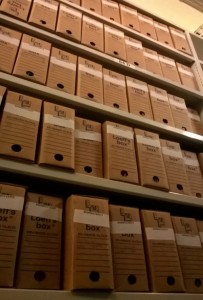“Three hundred boxes?! That’s a lot isn’t it?”
Me: “Erm..yeah I guess so”
“How do you even start to make sense of all that stuff?”
I’ve been having a few conversations along these lines at the moment. The non-archivist I’m talking to will look puzzled as I say the key words: New job. Tavistock Institute of Human Relations (TIHR). 300+ boxes. 2 years. Archive. Cataloguing.
They might picture hundreds of boxes full of thousands of documents and agree that yes, that does seem like A Lot of Stuff. They might nod at the right points in the conversation, but then just when I think I’ve managed to explain what the job involves, they’ll turn around and say: “yeah, but what do you actually do?”

And it’s a very good question. Introducing yourself as an archivist at a party is an easy way to create an awkward silence. Turns out it’s not the same as saying you’re a teacher, or a doctor or a fireman – one of those nice ordinary jobs that everyone understands. Usually if you say you’re an archivist people look at you blankly, or ask if you mean an architect, or an archaeologist, as if professions beginning with an arc- prefix are interchangeable.
Once you start explaining what the role involves, it gets even more confusing and people either think it sounds like the most boring job in the world (I think this is when I describe it as being “a bit like organising a massive spice rack only lots more fun and with historical documents”) or the most exciting thing ever (“I get to read and interpret people’s letters and diaries and then come up with fun ways to get the public excited about their history”). It’s not an easy job to describe.

As the Institute’s Archivist, my role is to hold the institutional memory of the TIHR. This means making TIHR’s history accessible; both so that it can be used by researchers, but also so that it can be used by colleagues at the Institute to reflect on contemporary practise. The idea is that the archive becomes central to the Institute’s way of thinking and reflecting – not simply a historical resource, but also a touchstone for memory, an antidote to amnesia, and a way of re-engaging with the past to contemplate how the organisation works today.

In practical terms, this means I need to sort through the masses of documentation accumulated by the Institute to create some order and make sense of it all. At the moment, it would be impossible for a researcher to know what records are held in those boxes, or how to find the materials that are most relevant to them. I need to understand the Institute well enough to be able to impose some structure on the materials, to think about where those documents originated from, why they were created, and how they would sit in an archive hierarchy. I then need to sort through those records; defining and interpreting them and describing them so that researchers can find the material of most use to them.

But there’s no point just quietly cataloguing those papers if nobody knows that they are available, or knows what their potential research value is. Another part of my role as TIHR Archivist is to produce and implement a communications and audience development plan for the collection. This means thinking of exciting ways to engage people in the collection, considering the broad and diverse topics covered in the archive, and trying to think of who the archive might appeal to.
In 2016 and 2017, we’ll be announcing events and activities to reflect on the project, and to celebrate the phased releases of sections of the collection. This is a journey that will be documented in the blog, and I’ll also use this as a space to reflect on archival practise, on the process of cataloguing the collection, and bringing the archive into the light.